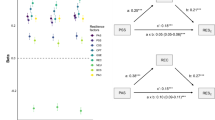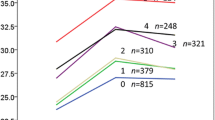Abstract
Background
Exposure to ongoing political violence and stressful conditions increases the risk of posttraumatic stress disorder (PTSD) in low-resource contexts. However, much of our understanding of the determinants of PTSD in these contexts comes from cross-sectional data. Longitudinal studies that examine factors associated with incident PTSD may be useful to the development of effective prevention interventions and the identification of those who may be most at-risk for the disorder.
Methods
A 3-stage cluster random stratified sampling methodology was used to obtain a representative sample of 1,196 Palestinian adults living in Gaza, the West Bank and East Jerusalem. Face-to-face interviews were conducted at two time points 6-months apart. Logistic regression analyses were conducted on a restricted sample of 643 people who did not have PTSD at baseline and who completed both interviews.
Results
The incidence of PTSD was 15.0 % over a 6-month period. Results of adjusted logistic regression models demonstrated that talking to friends and family about political circumstances (aOR = 0.78, p = 0.01) was protective, and female sex (aOR = 1.76, p = 0.025), threat perception of future violence (aOR = 1.50, p = 0.002), poor general health (aOR = 1.39, p = 0.005), exposure to media (aOR = 1.37, p = 0.002), and loss of social resources (aOR = 1.71, p = 0.006) were predictive of incident cases of PTSD.
Conclusions
A high incidence of PTSD was documented during a 6-month follow-up period among Palestinian residents of Gaza, the West Bank, and East Jerusalem. Interventions that promote health and increase and forestall loss to social resources could potentially reduce the onset of PTSD in communities affected by violence.
Similar content being viewed by others
References
B’Tselem (2008) Fatalities in the first Intifada http://www.btselem.org/english/statistics/First_Intifada_Tables.asp. Accessed Oct 14 2008
B’Tselem (2008) Intifada fatalities http://www.btselem.org/english/statistics/Casualties.asp. Accessed Oct 14 2008
B’Tselem (2008) Statistics on Palestinians in the custody of the Israeli security forces http://www.btselem.org/english/statistics/Detainees_and_Prisoners.asp. Accessed Oct 14 2008
Hobfoll SE, Hall BJ, Canetti D (2012) Political violence, psychological distress, and perceived health: a longitudinal investigation in the Palestinian Authority. Psychological trauma 4(1):9–21
Punamaki R-L, Komproe IH, Qouta S, Elmasri M, de Jong JVM (2005) The Role of Peritraumatic Dissociation and Gender in the Association Between Trauma and Mental Health in a Palestinian Community Sample. Am J Psychiatry 162(3):545–551
Canetti D, Galea S, Hall BJ, Johnson RJ, Palmieri PA, Hobfoll SE (2010) Exposure to prolonged socio-political conflict and the risk of PTSD and depression among Palestinians. Psychiatry 73(3):219–231
Heath NM, Hall BJ, Russ EU, Canetti D, Hobfoll SE (2012) Reciprocal relationships between resource loss and psychological distress following exposure to political violence: an empirical investigation of COR theory’s loss spirals. Anxiety Stress Coping 25(6):679–695
Bleich A, Gelkopf M, Solomon Z (2003) Exposure to terrorism, stress-related mental health symptoms, and coping behaviors among a nationally representative sample in Israel. JAMA 290(5):612–620
Neria Y, Besser A, Kiper D, Westphal M (2010) A longitudinal study of posttraumatic stress disorder, depression, and generalized anxiety disorder in Israeli civilians exposed to war trauma. J Trauma Stress 23(3):322–330
De Jong JTVM, Komproe IH, Van Ommeren M et al (2001) Lifetime events and posttraumatic stress disorder in four postconflict settings. JAMA 286:555–562
Hobfoll SE, Canetti-Nisim D, Johnson RJ, Palmieri PA, Varley JD, Galea S (2008) The association of exposure, risk, and resiliency factors with PTSD among Jews and Arabs exposed to repeated acts of terrorism in Israel. J Trauma Stress 21(1):9–21
Bleich A, Gelkopf M, Melamed Y, Solomon Z (2006) Mental health and resiliency following 44 months of terrorism: a survey of an Israeli national representative sample. BMC Med 4:21
Miller KE, Rasmussen A (2010) War exposure, daily stressors, and mental health in conflict and post-conflict settings: bridging the divide between trauma-focused and psychosocial frameworks. Soc Sci Med 70(1):7–16
Hobfoll SE (1989) Conservation of resources. A new attempt at conceptualizing stress. Am Psychol 44(3):513–524
Hobfoll SE, Tracy M, Galea S (2006) The impact of resource loss and traumatic growth on probable PTSD and depression following terrorist attacks. J Trauma Stress 19(6):867–878
Dekel R, Hobfoll SE (2007) The impact of resource loss on Holocaust survivors facing war and terrorism in Israel. Aging Mental Health 11(2):159–167
Gelkopf M, Berger R, Bleich A, Silver RC (2012) Protective factors and predictors of vulnerability to chronic stress: a comparative study of 4 communities after 7 years of continuous rocket fire. Soc Sci Med 74(5):757–766
Hall BJ, Bonanno GA, Bolton PA, Bass JK (2014) A longitudinal investigation of changes to social resources associated with psychological distress among kurdish torture survivors living in northern Iraq. J Trauma Stress 27:446–453
Hobfoll SE, Mancini AD, Hall BJ, Canetti D, Bonanno GA (2011) The limits of resilience: distress following chronic political violence among Palestinians. Soc Sci Med 72(8):1400–1408
Cukor J, Wyka K, Jayasinghe N et al (2011) Prevalence and predictors of posttraumatic stress symptoms in utility workers deployed to the world trade center following the attacks of September 11, 2001. Depress Anxiety 28(3):210–217
Canetti D, Hall BJ, Rapaport C, Wayne C (2013) Exposure to political violence and political extremism: a stress-based process. Eur Psychol 18(4):263
Ahern J, Galea S, Resnick H et al (2002) Television images and psychological symptoms after the September 11 terrorist attacks. Psychiatry 65(4):289–300
Brewin CR, Andrews B, Valentine JD (2000) Meta-analysis of risk factors for posttraumatic stress disorder in trauma-exposed adults. J Consult Clin Psychol 68(5):748–766
Charuvastra A, Cloitre M (2008) Social bonds and posttraumatic stress disorder. Annu Rev Psychol 59:301–328
Veling W, Hall BJ, Joosse P (2013) The association between posttraumatic stress symptoms and functional impairment during ongoing conflict in the Democratic Republic of Congo. J Anxiety Disord 27(2):225–230
Johnson H, Thompson A (2008) The development and maintenance of post-traumatic stress disorder (PTSD) in civilian adult survivors of war trauma and torture: a review. Clin Psychol Rev 28(1):36–47
Galea S, Tracy M, Norris F, Coffey SF (2008) Financial and social circumstances and the incidence and course of PTSD in Mississippi during the first 2 years after Hurricane Katrina. J Trauma Stress 21(4):357–368
PCBS (1999) Population, housing, and establishment Census (1997) Locality type booklet. Palestinian Central Bureau of Statistics, Ramallah
PCBS (2008) Palestine in figures (2007) Palestinian Central Bureau of Statistics, Ramallah
Foa EB, Riggs DS, Dancu CV, Rothbaum BO (1993) Reliability and validity of a brief instrument for assessing post-traumatic stress disorder. J Trauma Stress 6(4):459–473
Association AP (2000) Diagnositic and statistical manual of mental disorders, 4th edn. American Psychiatric Press, Washington, DC
Hobfoll SE, Lilly RS (1993) Resource conservation as a strategy for community psychology. J Community Psychol 21(2):128–148
StataCorp (2012) STATA Version 12.1. College Station
Mehio-Sibai A, Feinleib M, Sibai TA, Armenian HK (2005) A positive or a negative confounding variable? A simple teaching aid for clinicians and students. Ann Eppidemiol 15:421–423
Hall BJ, Elhai JD, Grubaugh A, Tuerk P, Magruder K (2012) Examining the factor structure of PTSD between male and female veterans in primary care. J Anxiety Disord 26(3):409–415
Tolin DF, Foa EB (2006) Sex differences in trauma and posttraumatic stress disorder: a quantitative review of 25 years of research. Psychol Bull 132(6):959–992
Hobfoll SE, Canetti-Nisim D, Johnson RJ (2006) Exposure to terrorism, stress-related mental health symptoms, and defensive coping among Jews and Arabs in Israel. J Consult Clin Psychol 74(2):207–218
Janoff-Bulman R (1992) Shattered assumptions: towards a new psychology of trauma New York. The Free Press, New York
Pacella ML, Hruska B, Delahanty DL (2013) The physical health consequences of PTSD and PTSD symptoms: a meta-analytic review. J Anxiety Disord 27(1):33–46
Asmundson GJG, Coons MJ, Taylor S, Katz J (2002) PTSD and the experience of pain: research and clinical implications of shared vulnerability and mutual maintenance models. Can J Psychiatry 47(47):930–937
McEwen BS, Stellar E (1993) Stress and the Individual: mechanisms leading to disease. Arch Intern Med 153:2093–2101
Hall BJ, Bolton P, Annan J et al (2014) The effect of cognitive therapy on structural social capital: results from a randomized controlled trial among sexual violence survivors in the Democratic Republic of Congo. Am J Public Health 104:1680–1686
Acknowledgments
This research was made possible in part by a grant from the National Institute of Mental Health (RO1MH073687) and the Ohio Board of Regents. Dr. Hall was supported by the National Institute of Mental Health T32 in Psychiatric Epidemiology (T32MH014592-35) and through the Fogarty Global Health Fellows Program (1R25TW009340-01). Sarah Murray was supported by National Institute of Mental Health National Research Service Award (F31 5F31MH099959-02).
Conflict of interest
On behalf of all authors, the corresponding author states that there is no conflict of interest.
Author information
Authors and Affiliations
Corresponding author
Rights and permissions
About this article
Cite this article
Hall, B.J., Murray, S.M., Galea, S. et al. Loss of social resources predicts incident posttraumatic stress disorder during ongoing political violence within the Palestinian Authority. Soc Psychiatry Psychiatr Epidemiol 50, 561–568 (2015). https://doi.org/10.1007/s00127-014-0984-z
Received:
Accepted:
Published:
Issue Date:
DOI: https://doi.org/10.1007/s00127-014-0984-z




